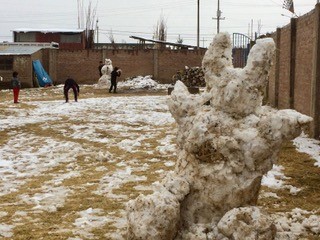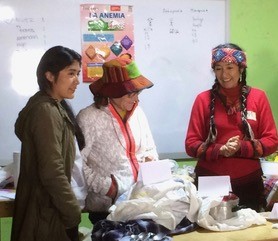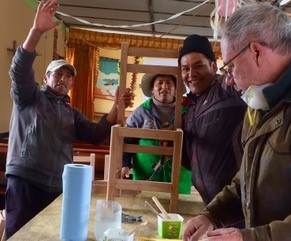A Letter from Rusty Edmondson and Sara Armstrong, serving in Peru
September 2018
Write to Sara Armstrong
Write to Rusty Edmondson
Individuals: Give online to E200530 for Sara Armstrong and Rusty Edmondson’s sending and support
Congregations: Give to D507510 for Sara Armstrong and Rusty Edmondson’s sending and support
Churches are asked to send donations through your congregation’s normal receiving site (this is usually your presbytery).
Subscribe to our letters
One of the big challenges for our work in Peru over the years has been helping Peruvians understand what can be accomplished with short-term teams in a week. Most US teams arrive in Peru on a Friday night and return home the following weekend. There are a few, but very important, guidelines that direct our work and highlight the possible achievements.
1) Short-term Mission is much more effective if the teams return each year to continue the work and the relationships that they established the first year. The Webster Presbyterian Church in Houston, Texas, just finished their fifth year partnering with the Iglesia Evangelica Peruana in Ayaviri, a small town that is a hub for the central part of Puno in southern Peru. This church was started by British missionaries 60 years ago. The missionaries purchased a city block, walled it in, and then built a mission house and a small adobe church. This site, because it is large, has become a center for the activities of the Synod of Puno and the Presbytery of Ayaviri.
2) The local Peruvian church defines the work they will do with their partner based on the needs and vision of their church.
A) The need to establish Sunday schools and train teachers for the whole Synod of Puno led to a multi-day training event that has been held each year over the last five years. Most of the churches in the synod now have Sunday School programs. The team started out teaching the program and now helps the synod to provide teachers in the native Quechua language.
B) The partners also have sponsored a nutrition workshop for the synod women over the last three years. The lack of good healthcare in the area has led people to rely on traditional herbal medicines, but the wisdom of how to select and prepare these plants is dying out with the oldest generation. Nutrition is also impacted by their geography and by cheap foods flooding the markets. Their location at 13,000 feet above sea level in the Andes mountains makes it difficult to grow vegetables and herbs. These high, dry grasslands are good for cattle, sheep, potatoes and grains, so the diet has traditionally been meat, potatoes, quinoa, corn and cheese. The huge international demand for grains like quinoa and kiwicha means the prices are soaring, and it is cheaper to buy white rice and white noodles, which have much lower nutritional values. All these factors play into nutritional problems like anemia, infections, parasites and obesity.
The nutrition workshop is taught by Urpi Luna in Quechua. It is fascinating to watch the women in their regional dress — several full skirts, handknitted tights, sweaters and a manta (traditional blanket) pinned over the shoulders. Their long hair is usually parted and braided with ribbons, and the small Puneño bowler hat is perched on top. The women participate with enthusiasm, asking lots of questions, learning about and trying out nutritious recipes, laughing and competing for the kitchen items (towels, spatulas, hotpads, etc.) that the Webster team brings as prizes each year.
This year, a gynecologist accompanied the team and offered individual medical consults to each of the women. This involved translation from Quechua to Spanish to English and back for each question and answer. It took a long time, but it was really rewarding, as most of the problems we discussed had cures related to good diet and hygiene. We were delighted to learn about the herbal cures they use, especially from the older women. The prevalence of infections was distressing and will hopefully be addressed next year in a workshop instead of one-on-one meetings.
C) A knowledge of English is becoming increasingly necessary for higher studies. One of the young women of the church asked the team for intensive English lessons both for children and for adults. Four days of classes that combine book learning with art and practice pronouncing English have been very popular.
D) Each year, there is also a construction project. This year, we worked together on tables and chairs for Sunday School programs. Other years, we have helped build a kitchen with an interior horno (an earthen oven) and bathrooms and have installed solar panels. Most people in Ayaviri do not have ovens,.and cooking is done on portable gas stoves. Most homes do not have hot running water. So the “horno” style oven in the new kitchen is for communal use, as is the solar panel that provides hot water for the kitchen and showers.
3) Many churches would like to host a US team but are not clear on their church vision and thus cannot define a project. This has led us to encourage participation in long-range planning in churches and seminaries across Peru. Last year, a planning process was also a part of the Webster team visit, and the work continued after we left. It became abundantly clear in 2017 that the church was not ready to go forward with their new sanctuary project due to conflict within the congregation.
When we arrived in August of 2018, we found a congregation that had worked hard to address and resolve their conflicts. The dissenters were once again part of the congregation, the welcome was joyous and heartfelt, the activities were well attended, the worship attendees filled the church and new families are coming. This is a joy that has resulted from the prayers and encouragement between the partners.
So. What can be achieved with short-term teams?
The partnership between Webster Presbyterian Church and the Iglesia Evangelica Peruana de Ayaviri has had an impact synod-wide, as Sunday schools were started. It has resulted in peacemaking in the congregation, empowered leaders, cross-cultural healthcare, encouragement to learn a third language, and fulfilling visits.
This city at such a high altitude is usually warm by day and quite cold at night. This year, we were all surprised by two inches of snow during the team’s August visit. The children were thrilled. With help from US visitors who were more used to snow, the church grounds were soon covered with snowmen and snow animals. They provided a source of snow for snowball fights all day. It just reminds me that you never can know the full effects of short-term Mission in rural Peru. There will always be surprises, and there will always be unexpected blessings.
Many of you who are reading this have helped with the finances that make it possible for us to coordinate short-term mission work in Peru. Thank you for making it possible for us to see this transformation and growth firsthand. For those who would like to give, you can do so here: pcusa.org/donate/E200530.
We also want to let you know that we will be on itineration assignment from September to December of 2018. We would be glad to visit your church and speak about our work.
Thank you again!
Sara and Rusty
![]() You may freely reuse and distribute this article in its entirety for non-commercial purposes in any medium. Please include author attribution, photography credits, and a link to the original article. This work is licensed under a Creative Commons Attribution-NonCommercial-NoDeratives 4.0 International License.
You may freely reuse and distribute this article in its entirety for non-commercial purposes in any medium. Please include author attribution, photography credits, and a link to the original article. This work is licensed under a Creative Commons Attribution-NonCommercial-NoDeratives 4.0 International License.




